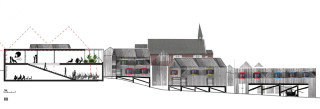Arctic Urban Landscapes of Tasiilaq

In collaboration with Future North and Kommuneqarfik Sermersooq, two master studios at the Institute of Urbanism and Landscape and the Tromsø Academy of Landscape and Territorial Studies (both AHO) have studied the urban landscapes of Tasiilaq, Eastern Greenland.
About the studios:
Urban Design – Arctic City (The Institute of Urbanism and Design, AHO)
Teachers: Peter Hemmersam, Lisbet Harboe
Tasiilaq is a growing city and the only city of the Greenlandic east coast. The transformation from small settlements and nomadic lifestyles to an urban community makes the development of an Arctic Urbanism crucial.
– What are the future prospects for Tasiilaq?
– What potential exists in the combination of modern life and the traditional one of hunting and fishing?
– How can we facilitate a reconceptualised urbanisation in the Arctic city?
These are questions discussed in this studio and the student projects provide interesting answers.
The students thoroughly mapped Tasiilaq and met with a range of actors and inhabitants. These investigations revealed a manifold of local resources and important challenges, which the students include and respond to in their projects.
You can download the studio booklet here.
Arctic Cities: New spaces in Tasiilaq (Tromsø Academy of Landscape and Territorial Studies)
Teachers: Alf Haukeland, Mari Bergset, Mats Kemppe
Tasiilaq is a community of about 2 000 people and is the largest settlement on the Greenlandic east coast. It is growing due to immigration from settlements in the region, and faces several challenges with regards to sustainable growth. It poses emblematic challenges for an arctic urban development that is not connected to resource extraction.
With a good airplane connection to Reykjavik and a spectacular landscape of mountains, icebergs and wildlife, Tasiilaq could potentially grow as a tourist destination. However the city has infrastructural challenges: the airport is located on an island, separated from Tasiilaq. The harbor freezes over in the winter, posing a general problem for goods and people transportation. At the same time the city has a series of urban spaces that need upgrading both with regards to physical design, functionality and structural logic.
The student projects will be exhibited at AHO from 15th to the 17th December 2014.
(Image: Kristine Skarphol)



